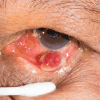Pyogenic Granuloma Diagnosis and Management: A Practical Review
- PMID: 39281092
- PMCID: PMC11398770
- DOI: 10.1097/GOX.0000000000006160
Pyogenic Granuloma Diagnosis and Management: A Practical Review
Abstract
Background: Pyogenic granuloma (PG), or lobular capillary hemangioma, poses a clinical challenge with its uncertain etiology and treatment options. Although the clinical features and prevalence of PGs are well established, definitive evidence-based treatments remain elusive. This practical review aims to illuminate the complexities of PG management by analyzing surgical interventions based on literature analysis.
Methods: A PubMed/Medline search of "pyogenic granuloma" and "surgery" yielded 1171 studies. Inclusion criteria targeted intervention-associated PG complications over 5% and treatment modalities, excluding nonclinical studies and topics unrelated to plastic and reconstructive surgery. Screening involved Oxford level of evidence, patient data extraction, complications, intervention types, success rates, sessions, follow-ups, and treatments.
Results: Thirty-one studies met inclusion criteria. Most studies were retrospective (67.7%). Ten studies satisfied intervention-linked eruptions, primarily oculoplastic, whereas 21 investigated both surgical and nonsurgical treatment modalities. Across interventions, 3579 patients (age: 34.2-85.7 years) were involved. Postsurgical PG complications averaged 15.1% and were treated predominantly with surgical excision, achieving nearly complete resolution. Surgical and nonsurgical treatment studies included 1233 patients (age: 3-46.5 years), demonstrating a 68.2% average resolution after a single session, with surgical excision exhibiting the highest success rate (96.2%) and minimal complications.
Conclusions: This practical review highlights the complexities of managing PG, emphasizing a spectrum of effective treatments and potential postoperative complications. Ophthalmologic procedures showed PG incidences of 9%-24.4%. Surgical excision proved highly effective, surpassing methods like lasers and injectables that exhibited varied success rates requiring multiple treatment sessions. Challenges included study diversity and varying evidence levels, warranting further comparative research for PG management strategies.
Copyright © 2024 The Authors. Published by Wolters Kluwer Health, Inc. on behalf of The American Society of Plastic Surgeons.
Conflict of interest statement
Dr. Janis receives royalties from Springer Publishing and Thieme Publishers. The other author has no financial interest to declare in relation to the content of this article.
Figures









Similar articles
-
Lobular Capillary Hemangioma Masquerading as Pyogenic Granuloma of Anterior Mandible: A Case Report.Cureus. 2023 Jul 19;15(7):e42157. doi: 10.7759/cureus.42157. eCollection 2023 Jul. Cureus. 2023. PMID: 37602023 Free PMC article.
-
Two pediatric cases of pyogenic granuloma treated with imiquimod 5% cream: combined clinical and dermatoscopic evaluation and review of the literature.G Ital Dermatol Venereol. 2013 Feb;148(1):147-52. G Ital Dermatol Venereol. 2013. PMID: 23407084 Review.
-
A case of pyogenic granuloma and its unique way of management.Int J Surg Case Rep. 2025 Apr;129:111200. doi: 10.1016/j.ijscr.2025.111200. Epub 2025 Mar 25. Int J Surg Case Rep. 2025. PMID: 40158357 Free PMC article.
-
Behavioural interventions for type 2 diabetes: an evidence-based analysis.Ont Health Technol Assess Ser. 2009;9(21):1-45. Epub 2009 Oct 1. Ont Health Technol Assess Ser. 2009. PMID: 23074526 Free PMC article.
-
Treatment options for cutaneous pyogenic granulomas: a review.J Plast Reconstr Aesthet Surg. 2011 Sep;64(9):1216-20. doi: 10.1016/j.bjps.2010.12.021. Epub 2011 Feb 11. J Plast Reconstr Aesthet Surg. 2011. PMID: 21316320 Review.
Cited by
-
Clinical observation of pyogenic granuloma treated with combined long-pulse 1064nm Nd: YAG laser and pulsed CO2 laser photodynamic therapy.Lasers Med Sci. 2025 Jun 17;40(1):287. doi: 10.1007/s10103-025-04518-4. Lasers Med Sci. 2025. PMID: 40526166
References
-
- Poncet A, Dor L. Botryomycosis humaine. Rev de Chir. 1897;18:996–997.
-
- Goss JA, Greene AK. Congenital vascular tumors. Otolaryngol Clin North Am. 2018;51:89–97. - PubMed
-
- Ribeiro JL, Moraes RM, Carvalho BFC, et al. . Oral pyogenic granuloma: an 18-year retrospective clinicopathological and immunohistochemical study. J Cutan Pathol. 2021;48:863–869. - PubMed
-
- Rastogi K, Singh L, Khan NA, et al. . Benign vascular anomalies: a transition from morphological to etiological classification. Ann Diagn Pathol. 2020;46:151506. - PubMed
Publication types
LinkOut - more resources
Full Text Sources
Miscellaneous
